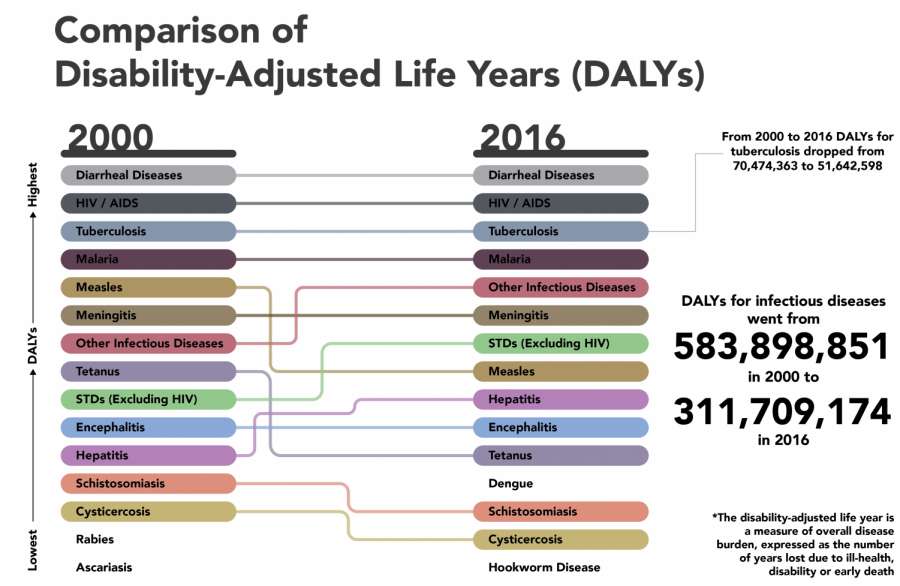Science Scoop: New, more effective tuberculosis vaccine developed
February 2, 2020
The origins of vaccines go back to the turn of the 19th century when Edward Jenner noticed that dairymaids who had been previously infected with cowpox were immune to smallpox. From there, he created the first “vaccine” — he gave patients cowpox to protect them from the more deadly smallpox.
But a Pitt researcher is putting a new spin on the old model of giving vaccines to patients.
Pitt researcher JoAnne Flynn published a January study that found that a tuberculosis vaccine injected intravenously — administered via the bloodstream — is more effective than the same vaccine injected into the muscle. The current TB vaccine remains largely ineffective, and 1.5 million people died of the disease in 2018, according to a World Health Organization report.
Intravenous vaccines are a modern conception — there are no intravenous vaccines currently on the market, according to Flynn. The only other intravenous vaccine — an experimental malaria vaccine being developed at the National Institutes of Health — was Flynn’s inspiration.
“[The vaccine] proved to be protective against malaria in monkeys and in human challenge trials,” Flynn said. “This led us to think that delivery of a vaccine [intravenously] might work for TB too.”
Flynn tested the TB vaccine in a trial with monkeys and found that the monkeys given the vaccine did not get TB. The unvaccinated monkeys became sick with the disease.
According to Pitt influenza researcher Seema Lakdawala, the idea of an intravenous vaccine comes from the idea that vaccines are most effective if they are administered to the place where the virus or bacteria replicates.
“A big idea back in the ’70s and ’80s was if you gave a live, attenuated vaccine straight to the sites where flu virus replicates, to your upper respiratory tract, you would have a better immune response,” Lakdawala said. “And that does seem to be the case in kids. It’s not very effective in adults.”
Lakdawala said this likely occurs because everyone develops an immune response to the flu by age 5.
Lakdawala said an interesting problem in vaccine research is the connection between efficacy and the means of administration. Like the flu vaccine, the intramuscular TB vaccine isn’t completely protective, motivating Flynn and other researchers to look for a better solution because a vaccine is not a guarantee of no disease, according to Lakdawala.
“If you have a vaccine, you’re more likely to be protected,” Lakdawala said. “You might still get the flu, but you’re less likely to have a very severe flu infection.”
The TB vaccine is made of a live, attenuated — weakened — version of the bacteria, but not every patient can receive an attenuated vaccine. Even with the more effective intravenous vaccine, an immunocompromised patient — one with a weak immune system — cannot receive the new vaccine.
Immunocompromised patients are especially susceptible to disease. For example, newborn babies, who haven’t had time to build up immunity, are considered to be immunocompromised, alongside patients with HIV/AIDS and those undergoing chemotherapy. Having a compromised immune system means a person might not be strong enough to fight off a vaccine.
According to Pitt researcher Doug Reed, attenuated vaccines aren’t safe for immunocompromised patients.
“Attenuated vaccines are very good … they generate the most immunity,” Reed said. “The problem is that immunocompromised patients … cannot receive a live vaccine.”
Instead of direct protection from vaccines, immunocompromised people can still stay safe indirectly. They rely on herd immunity, the idea that if enough members of a population are vaccinated, everyone is protected from the disease. The percentage of the population that must be vaccinated depends on how contagious the disease is and how well the vaccine works.
Since the TB vaccine is not totally protective and the disease is highly contagious, a single TB incident can quickly spread throughout a population. About 13 million people in the United States have a latent, or inactive, TB infection, according to the Center for Disease Control and Protection. Of those, only 9,025 people got sick with TB disease. The CDC says a latent TB infection activates when a patient becomes immunocompromised.
Lakdawala said it is critical that those with immune systems that can tolerate the vaccines do utilize them, to protect themselves and others.
“A lot of the mortality cases right now are people who are unvaccinated,” Lakdawala said. “I think it’s an important message that we all take care.”




